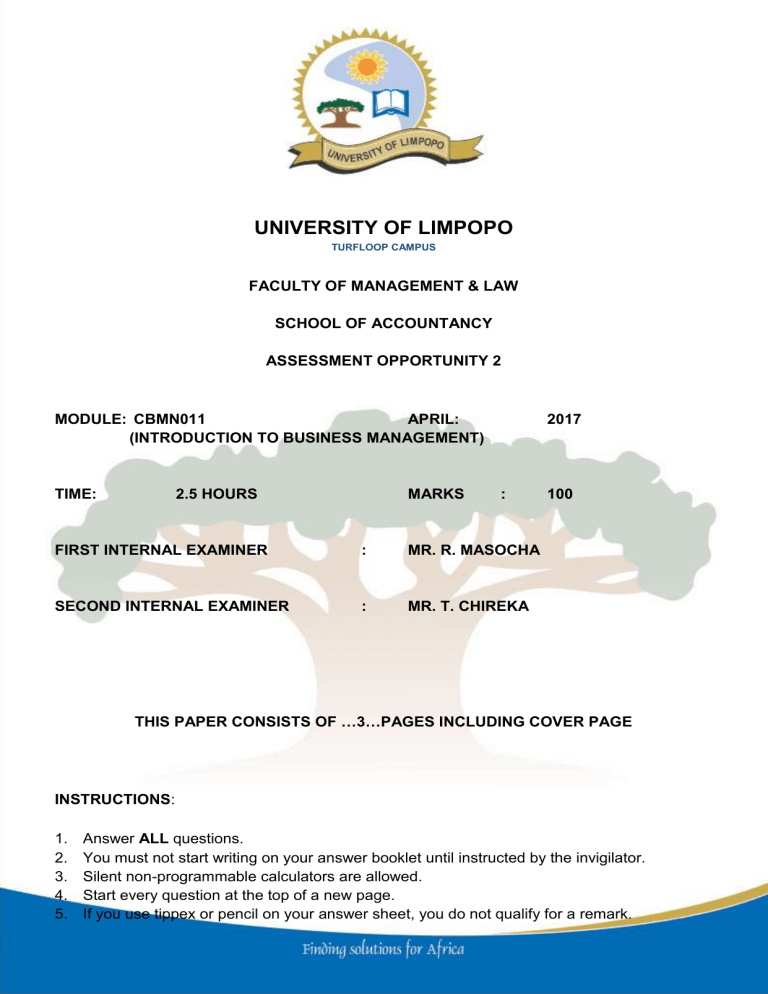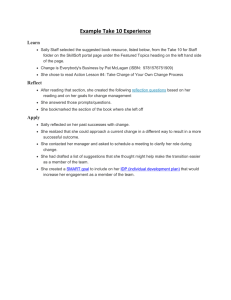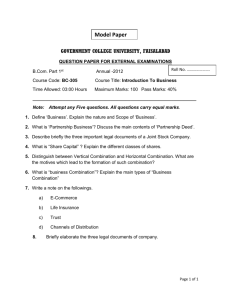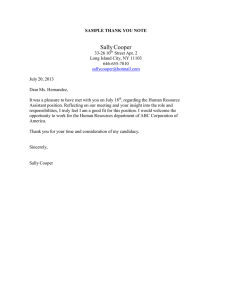
UNIVERSITY OF LIMPOPO TURFLOOP CAMPUS FACULTY OF MANAGEMENT & LAW SCHOOL OF ACCOUNTANCY ASSESSMENT OPPORTUNITY 2 MODULE: CBMN011 APRIL: (INTRODUCTION TO BUSINESS MANAGEMENT) TIME: 2.5 HOURS MARKS 2017 : FIRST INTERNAL EXAMINER : MR. R. MASOCHA SECOND INTERNAL EXAMINER : MR. T. CHIREKA 100 THIS PAPER CONSISTS OF …3…PAGES INCLUDING COVER PAGE INSTRUCTIONS: 1. 2. 3. 4. 5. Answer ALL questions. You must not start writing on your answer booklet until instructed by the invigilator. Silent non-programmable calculators are allowed. Start every question at the top of a new page. If you use tippex or pencil on your answer sheet, you do not qualify for a remark. 6. Scratch out open spaces and empty pages. CASE STUDY: Read the article below and answer the questions that follow Leadership Case Study Inspires and Motivates Others to High Performance: Sally and David MTCR is a leading company in the development and manufacturing of a broad range of custom hardware solutions. The company prides itself and is well known for being refreshingly honest and straightforward in its dealings with customers and employees, and in its ability to deliver difficult projects on time. Sally has been a senior manager at MTCR for four years and leads a team in the custom services area of the company. In a recent 360-degree survey, Sally scored above average (at the 70th percentile) in the competency, Inspires and Motivates Others to High Performance. Her report also indicated that her manager, peers, and direct reports saw this competency as a critical one for someone in her position. Some of the written comments in her survey indicated that if she demonstrated and applied this competency more often, it would have a significant positive impact on her success on the job. For these reasons, she’s focusing her personal leadership development over the next year on this competency. David is one of Sally’s direct reports who has worked at MTCR for more than nine years and whose historical performance has been excellent. It’s generally known among the team that David doesn’t have as strong a technical background as most of his colleagues. At the same time it’s also well known that he has a very efficient work style and puts in any extra hours needed to meet personal and team goals. He transferred from a different group and joined Sally’s team almost two years ago. Unfortunately, David has had several performance setbacks on the job over the last three months. One of them revolved around some critical missed assignments and late deliveries. Sally had assigned him two projects with some stretch goals that were not easy for David to hit, but had made those assignments specifically to give him development opportunities he had requested. This approach was typical for her, as she generally has a positive approach and displays confidence in her team members. She had worked together with him on his plans, and had checked in regularly with him during the weeks leading up to the delivery dates. Each time she 2|Page was assured by him that everything was on track. These were very visible failures that ended up impacting the performance of Sally’s entire team. The other setbacks were related to workplace confrontations he had at different times with several of his teammates following the missed assignments. Sally has met often with David during these last few months. She moved quickly to call out his missed responsibilities and improper behavior, wanting to be clear to him and the team that she was holding him accountable for his actions. She interviewed David’s teammates to get their understanding of what happened and the impact these situations were having on them and the team. She’s also spent a good deal of time with David to get his perspective, trying to understand what’s been behind David’s unusual behavior and to help him get back on track. During her meetings with him, she sometimes downplayed the seriousness of the situations in order to make him feel better about himself. During Sally’s coaching meetings with David over the last two weeks, she learned that there are several things that are likely contributing to David’s recent performance issues. He shared some personal financial and family issues that clearly have him worried. He’s also concerned about some process and role changes on the team that Sally instituted a few months ago that have caused changes in his day-to-day work responsibilities. David has accepted Sally’s feedback and recognized and taken responsibility for his actions. Although his personal issues are improving, they’re still an obvious worry to him. He’s also clearly stuck on how to handle the changes in his job. One of Sally’s greatest concerns is how to get this formerly excellent performer back on track and contributing more, despite David’s obvious discouragement and lack of confidence. Question 1 Discuss the components of the leading function. Support your answer by making (25 marks) reference to the case study given above. Question 2. (a) Describe the four drivers for organisations to embark on corporate social (16 marks) responsibility (CSR) programs (b) It is important that employees and stakeholders perceive their leaders as (5 marks) trustworthy. Explain the five dimensions of trust. (c) Despite the obvious benefits of planning, it can also result in certain costs. (4 marks) Briefly explain the four kind of costs that planning can cause for an organisation. 3|Page Question 3. (a) Name and briefly explain the 11 examples of corporate strategies that firms (11 marks) can follow during the planning process. (b) Name and explain the 3 different types of teams (6 marks) (c) State and briefly explain any FOUR of the FIVE characteristics of an (8 marks) effective control system. Question 4 (a) Identify and discuss briefly the three major theories used to determine the (9 marks) key characteristics and behaviour patterns of a good leader. (b) Describe the five factors that influence organisational structure (10 marks) (c) Budgets are used as control mechanisms by managers. Name the three (6 marks) types of budgets and mention what they focus on. The End 4|Page




